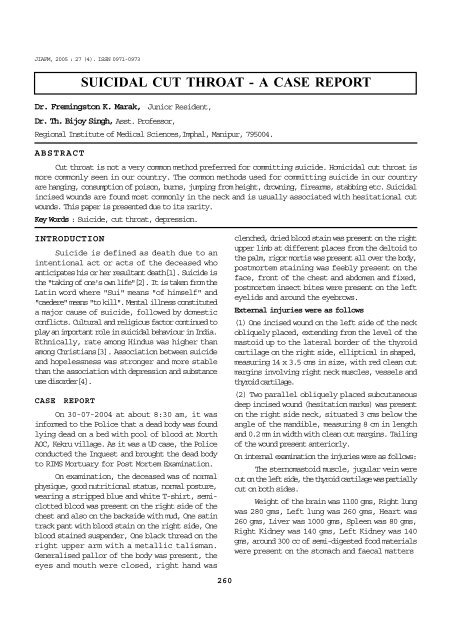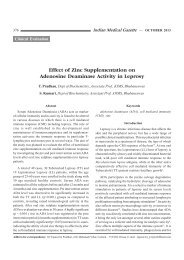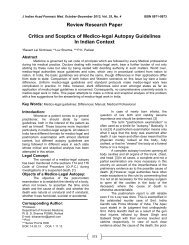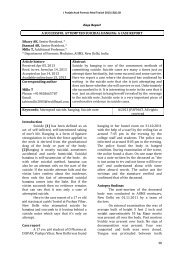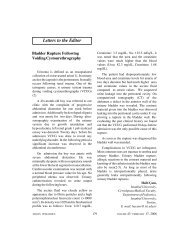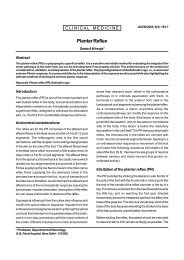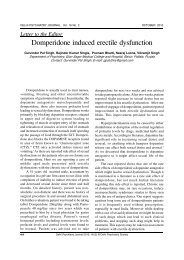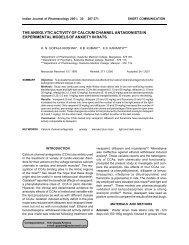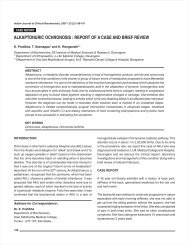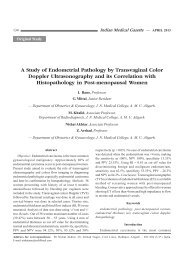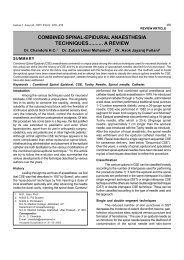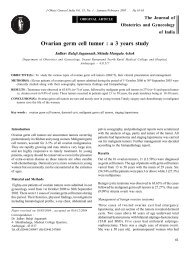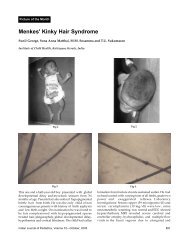SUICIDAL CUT THROAT - A CASE REPORT - medIND
SUICIDAL CUT THROAT - A CASE REPORT - medIND
SUICIDAL CUT THROAT - A CASE REPORT - medIND
Create successful ePaper yourself
Turn your PDF publications into a flip-book with our unique Google optimized e-Paper software.
JIAFM, 2005 : 27 (4). ISSN 0971-0973<br />
<strong>SUICIDAL</strong> <strong>CUT</strong> <strong>THROAT</strong> - A <strong>CASE</strong> <strong>REPORT</strong><br />
Dr. Fremingston K. Marak, Junior Resident,<br />
Dr. Th. Bijoy Singh, Asst. Professor,<br />
Regional Institute of Medical Sciences,Imphal, Manipur, 795004.<br />
ABSTRACT<br />
Cut throat is not a very common method preferred for committing suicide. Homicidal cut throat is<br />
more commonly seen in our country. The common methods used for committing suicide in our country<br />
are hanging, consumption of poison, burns, jumping from height, drowning, firearms, stabbing etc. Suicidal<br />
incised wounds are found most commonly in the neck and is usually associated with hesitational cut<br />
wounds. This paper is presented due to its rarity.<br />
Key Words : Suicide, cut throat, depression.<br />
INTRODUCTION<br />
Suicide is defined as death due to an<br />
intentional act or acts of the deceased who<br />
anticipates his or her resultant death[1]. Suicide is<br />
the "taking of one's own life"[2]. It is taken from the<br />
Latin word where "Sui" means "of himself" and<br />
"caedere" means "to kill". Mental illness constituted<br />
a major cause of suicide, followed by domestic<br />
conflicts. Cultural and religious factor continued to<br />
play an important role in suicidal behaviour in India.<br />
Ethnically, rate among Hindus was higher than<br />
among Christians[3]. Association between suicide<br />
and hopelessness was stronger and more stable<br />
than the association with depression and substance<br />
use disorder[4].<br />
<strong>CASE</strong> <strong>REPORT</strong><br />
On 30-07-2004 at about 8:30 am, it was<br />
informed to the Police that a dead body was found<br />
lying dead on a bed with pool of blood at North<br />
AOC, Kekru village. As it was a UD case, the Police<br />
conducted the Inquest and brought the dead body<br />
to RIMS Mortuary for Post Mortem Examination.<br />
On examination, the deceased was of normal<br />
physique, good nutritional status, normal posture,<br />
wearing a stripped blue and white T-shirt, semiclotted<br />
blood was present on the right side of the<br />
chest and also on the backside with mud, One satin<br />
track pant with blood stain on the right side, One<br />
blood stained suspender, One black thread on the<br />
right upper arm with a metallic talisman.<br />
Generalised pallor of the body was present, the<br />
eyes and mouth were closed, right hand was<br />
260<br />
clenched, dried blood stain was present on the right<br />
upper limb at different places from the deltoid to<br />
the palm, rigor mortis was present all over the body,<br />
postmortem staining was feebly present on the<br />
face, front of the chest and abdomen and fixed,<br />
postmortem insect bites were present on the left<br />
eyelids and around the eyebrows.<br />
External injuries were as follows<br />
(1) One incised wound on the left side of the neck<br />
obliquely placed, extending from the level of the<br />
mastoid up to the lateral border of the thyroid<br />
cartilage on the right side, elliptical in shaped,<br />
measuring 14 x 3.5 cms in size, with red clean cut<br />
margins involving right neck muscles, vessels and<br />
thyroid cartilage.<br />
(2) Two parallel obliquely placed subcutaneous<br />
deep incised wound (hesitation marks) was present<br />
on the right side neck, situated 3 cms below the<br />
angle of the mandible, measuring 8 cm in length<br />
and 0.2 mm in width with clean cut margins. Tailing<br />
of the wound present anteriorly.<br />
On internal examination the injuries were as follows:<br />
The sternomastoid muscle, jugular vein were<br />
cut on the left side, the thyroid cartilage was partially<br />
cut on both sides.<br />
Weight of the brain was 1100 gms, Right lung<br />
was 280 gms, Left lung was 260 gms, Heart was<br />
260 gms, Liver was 1000 gms, Spleen was 80 gms,<br />
Right Kidney was 140 gms, Left Kidney was 140<br />
gms, around 300 cc of semi-digested food materials<br />
were present on the stomach and faecal matters
were present in the intestines.<br />
Death was opined as due to haemorrhagic<br />
shock resulting from incised wound on the neck<br />
produced by sharp weapon. Suicidal in nature. Time<br />
since death was given as 12-18 hours<br />
(approximately) at the time of autopsy. Injuries were<br />
antemortem in nature and fresh at the time of<br />
death.<br />
DISCUSSION<br />
Under Section 306 IPC, if any person commits<br />
suicide, whoever abets the commission of such<br />
suicide, shall be punished with imprisonment of<br />
either description for a term, which may extend to<br />
ten years, and shall be liable to fine. Under Section<br />
309 IPC, whoever attempts to commit suicide and<br />
does any act towards the commission of such<br />
offence, shall be punished with simple<br />
imprisonment for a term, which may extend to one<br />
year or with fine or with both[5]. Suicide is a problem<br />
with many facets from the psychiatric and<br />
psychological point of view on one hand and to the<br />
mechanic of the mode of death on the other. For<br />
every suicide there is a far larger number of<br />
attempted suicides and suicidal gesture, so that<br />
the successful suicides are merely the tip of the<br />
proverbial iceberg. According to WHO estimate,<br />
approximately 8,14,000 people died by suicide in<br />
the year 2000. In the past 45 years suicide rates<br />
have increased by 60% in some countries and<br />
suicide is now one of the three leading causes of<br />
death among those aged 15 - 34 years worldwide.<br />
This data clearly indicate that suicide is a serious<br />
public health problem[6]. In the present case study<br />
the victim was a 28-year-old male with a history of<br />
depression for the last few years. Suicidal deaths<br />
are attracting increasingly more attention from the<br />
medical professional and public health agencies.<br />
The common methods used for committing suicide<br />
in our country are hanging, consumption of poison,<br />
burns, jumping from height, drowning, firearms,<br />
stabbing etc. The choice of method used to commit<br />
suicide depends upon the availability of means,<br />
knowledge about lethal effectiveness and the<br />
victims' motivation and intent[7]. Regardless to any<br />
real or suspected trend, suicide is a public health<br />
problem by virtue of the present incidence[8].<br />
Agnihotri AK[9] stated that incised wounds are<br />
usually suicidal while chopped wounds (i.e. type of<br />
261<br />
JIAFM, 2005 : 27 (4). ISSN 0971-0973<br />
incised wound) and stab wounds are usually<br />
homicidal. They found the stab wound to be more<br />
common compared to cut throat in males as well<br />
as females. Suicidal incised wounds were found<br />
most commonly in the neck and wrist. The<br />
hesitation marks, which were superficial, were<br />
associated with the main wound in the neck region.<br />
The suicidal victims were found dead in their home.<br />
Injuries on the back and genitalia were uncommon<br />
in suicidals. According to Karisson T[10] stab<br />
wounds on the chest (horizontal) were commonest<br />
cause of suicide followed by cut in the wrist.<br />
According to his study, irrespective of sex, majority<br />
of both suicide and homicides took pace in the<br />
victim's home. In this present case the suicidal<br />
victim was found dead in his home with an incised<br />
wound in the neck and associated with hesitational<br />
wounds.<br />
CONCLUSION<br />
Cut throat is not the commonly preferred<br />
method for committing suicide. Homicidal cut throat<br />
injuries are more commonly found in others studies.<br />
The gravity of the situation that makes a person to<br />
commit suicide need to be dealt with and medical<br />
help should be provided once the person shows<br />
any symptoms and signs of suicidal tendency.<br />
Attempts should be made to reach out to this<br />
individuals and proper counseling should be done<br />
so as to enable them to cope with the situation.<br />
The public should also be made aware of Section<br />
306 and 309 IPC; because abetment of suicide is<br />
punishable under Sec. 306 IPC for a term, which<br />
may extend to 10 years and attempt to commit<br />
suicide is punishable under Sec. 309 IPC5 for a<br />
term, which may extend to 1 year, with fine or with<br />
both. The purpose of psychological autopsy are to<br />
identify factors that contributed to suicides, helps<br />
professional who work with suicidal client, prevent<br />
suicide in future and supplement findings on<br />
physical autopsy.<br />
References<br />
1. Horswell J. Suspicious Deaths,<br />
Encyclopedia of Forensic Sciences. Jay A<br />
Siegel, Pekka J Saukko and Geoffrey C<br />
Knupfer: Academic Press, San Diego, 2000,1:<br />
463.<br />
2. John P. Friel. Dorland's Illustrated Medical
JIAFM, 2005 : 27 (4). ISSN 0971-0973<br />
dictionary. 21st Edn. Igaku Shoin Ltd., Tokyo,<br />
1974; 1493.<br />
3. Sharma SD and Gopalakrishna R. Suicide -<br />
a retrospective study in a culturally distinct<br />
community in India. Int. J. Soc. Psychiatry.<br />
1978; 24 (1): 13-18.<br />
4. Kuo WH,Gallo JJ and Eaton WW.<br />
Hopelessness, depression, substance<br />
disorder, & suicidality - a 13 year community<br />
based study. Soc. Psychiatry Epidemiol. 2004<br />
; 39 (6): 497-501.<br />
5. The Indian Penal Code 1860 (Amendment<br />
Act. 1995), Universal's Criminal Manual;<br />
Universal Law Publishing Co. Pvt. Ltd., New<br />
Delhi. 2004; 476- 478.<br />
6. Jose MB, Alexandra F, Diego DL and Danuta<br />
W. Suicide and Mental disorders - do we know<br />
enough, British Journal of Psychiatry. 2003;<br />
183: 382-383.<br />
262<br />
7. Sharma BR, Sharma V, Harish D and Vij K:<br />
Suicides in Northern India - causes, method<br />
used and prevention. Med. Sci. Law. 2003;<br />
43 (3): 221-229.<br />
8. Chavan KD, Kachare RV and Golisk. Study<br />
of suicidal death in rural region of Beed district<br />
of Maharashtra, International Journal of<br />
Medical Toxicology & Legal Medicine. 1999;<br />
1 (2): 29-31.<br />
9. Agnihotri AK, Choudhury, Millo T, Murty OP.<br />
Sharp force fatalities - 3 year review.<br />
International Journal of Medical Toxicology<br />
& Legal Medicine. Jan-June 2001 ; 3 (2): 18-<br />
20.<br />
10. Karisson T. Sharp force homicides in the<br />
Stockholm area 1983-992, Forensic Science<br />
International. 1998; 94: 129-139.


